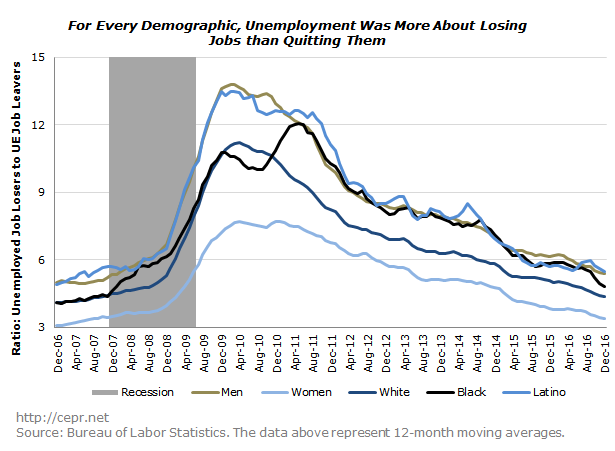February 01, 2017
During the height of the 2008-2009 recession, there was considerable debate about the origins of the soaring unemployment rate. The New York Times and other major media outlets said that the problem was mostly low demand, pointing out that there were more people searching for jobs than companies searching for workers. During the recession, companies decreased their monthly hiring by about a third, despite the fact that the number of Americans searching for work had more than doubled.
The data mostly indicate that workers weren’t choosing to stay unemployed; rather, they were losing their jobs and having trouble finding new ones. This can be seen most clearly by looking at the ratio of unemployed job losers to unemployed job leavers. Unemployed job losers are out of work because they lost their previous job; unemployed job leavers are out of work because they voluntarily left their last job. In 2006, there were roughly four unemployed job losers for every one unemployed job leaver; by early 2010, that ratio had shot up to nearly 11-to-1. This indicates that the vast majority of the drop in employment during the recession was due to companies laying off workers, not to workers leaving their jobs. Moreover, this phenomenon held true for every major demographic group, as can be seen in the figure below:

Based on these data, it’s clear why unemployment went up. It wasn’t because of workers’ mindsets or changing demographics – it’s because workers were losing their jobs and not being hired for new ones, pure and simple. Despite their protestations at the time, most political and economic commentators have now come to accept this view. It is generally acknowledged that blame shouldn’t be placed at the feet of the unemployed, who were merely victims of a weak economy.
So most pundits have accepted the correct view of the past. This doesn’t mean, however, that they are accepting the right view of the present. Many commentators currently argue that the labor market is at or near full employment (meaning that demand isn’t depressed and that the economy faces inflationary pressures) and that it only looks weak due to demographic changes. However, it is worth noting that the ratio of unemployed job losers to unemployed job leavers is elevated relative to 2006 for every demographic group. The ratio is up 7 percent for whites, 8 percent for men, 10 percent for women, 12 percent for Latinos, and 17 percent for blacks. This can be seen in the figure below, which compares the 2016 losers-to-leavers ratio (the dark blue bar) with the 2006 ratio (the light blue dot). While the economy is making good headway in recovering from the recession, it’s not at full employment yet.







